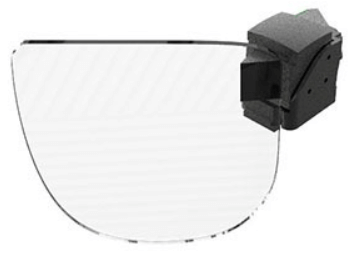As a consumer, it’s easy to think of AR glasses as a singular device. However, the devices are anything but monolithic artefacts. The frames, lenses, displays, computers, might all be made by different component manufacturers.
Lumus is an Israeli-based company with offices all around the world. The company makes waveguide displays that it sells to military or enterprise developers or to AR glasses manufacturers that you might already be more familiar with. We spoke with VP of Marketing, David Goldman, to learn more about the company, its products, and the markets it serves.
What Are “Waveguides” Again?
Before we get too far into Lumus in particular, let’s brush up on waveguides. There are a number of different approaches to displays in AR glasses. Waveguides use a projector and partially reflective mirrors embedded in a lens to project an image onto that lens.
“When it comes to consumer glasses, it’s going to be waveguides because that’s the lightest and the smallest display,” said Goldman. “If we’re actually going to call this [technology] ‘wearable,’ you have to be willing to go out on the street wearing it.”
Of course, size and style aren’t the only factors. A good display also has to be energy efficient enough for the end-product to have a usable battery life. The projection also needs to be bright enough that the AR glasses can be worn in different lighting conditions and environments, including outside.
“The whole idea of a consumer device that you can only use indoors doesn’t make a lot of sense,” said Goldman. Mind, Lumus doesn’t only (or even mainly) market to consumer projects. But, it’s an increasingly important market. More on that later.
A Brief History of Lumus
Lumus was founded in 2000 and, as many young tech companies do, spent the first few years developing intellectual property before focusing on actual production and marketing. Though the company does not yet turn a profit, Goldman reported over $100M over the last 11 years, not counting investments.
The company is still relatively small, consisting of about 80 people, though they’ve recently been on a hiring spree particularly looking to fill out their research and development department. When they did start selling, they found early success in military applications, particularly making components for heads-up displays used by pilots.
From there, Lumus parts started finding their way into the enterprise and medical devices. The company does have an in-house assembly line for their waveguides and projectors but also partners with SCHOTT for waveguides and Quanta for waveguides and projector modules.
Lumus has also developed a new production method with SCHOTT that should increase output and decrease cost. The company is also working with Luxexcel and other companies on innovative prescription eyewear solutions. Their components also show up in products by ThirdEye and Lenovo.
“Over the last few years, we’ve established a strong supply chain that will scale to the mass market for when everyone is wearing these things in the next 3-5 years,” said Goldman.
Different Parts for Different Uses

Lumus currently has four products shipping. All of the engines feature a similar basic design but the specs vary based on the target market. One of the biggest differences is the field of view. Enterprise clients often want a field of view between 20° and 30° for “assisted reality” or what Goldman calls “data snacking.” Consumers often want a larger FOV.
Assisted reality or “data snacking” presents notifications or small bits of information on the display without distracting too much from the physical environment, making it ideal for people in production roles. On the other hand, virtual screens are the main use case for consumer AR glasses applications right now, making a larger field of view more crucial.
The PD14 from Lumus is built for military avionics and has a 32° FOV, while the OE Maximus, built specifically for consumers, has a 50° FOV. Further, the company’s upcoming OE Minimus will have a FOV of about 20°. Goldman also told me that Lumus is teaming up with a gaming company to make a display around 60°, but he couldn’t reveal much more than that at this time.
When Will AR Glasses Really Be Here?
Working at a company with its hands in so many pies, Goldman has developed some interesting takes on the near-future of the AR glasses industry.
“We’re in an interesting place in the ecosystem,” said Goldman. “We’re a component but we’re at the heart. We’re dealing with all of these other set assembly companies because we’re the last mile.”
The companies using Lumus components don’t necessarily share the end-game for any given product with Lumus. However, Goldman has another method of keeping his finger on the pulse of the industry: patent watching.
“There’s a lot of activity in the consumer space. You didn’t see that two or three years ago. We’re on the precipice of an explosion,” said Goldman. “We can expect a lot to happen this year in terms of announcements and then availability in 2023.”
This isn’t to take away from Goldman’s prediction that mass adoption is still a number of years out. Availability and adoption are not the same thing. After all, there are already consumer AR glasses on the market but the odds are pretty good that you haven’t seen them on the city bus yet. When he talks about “mass adoption,” he means millions of regular users.
AR Is a Team Effort
It can be easy to just watch the products on the shelves. However, understanding the network of companies that come together to make that product is an important part of understanding AR and AR glasses. It will also become increasingly important as more of these products begin to compete for your money and attention.




